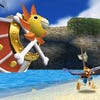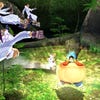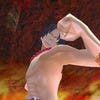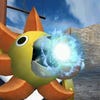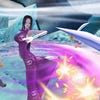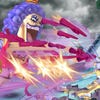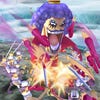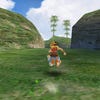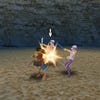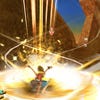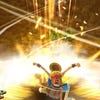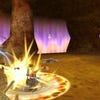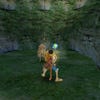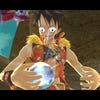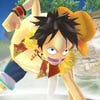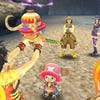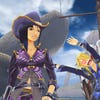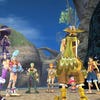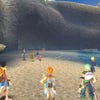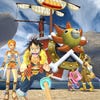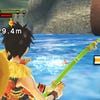One Piece: Unlimited Cruise SP Review
Luff at first sight.
The One Piece universe offers a clutch of potent ingredients for the prospective video game tie-in. For one, the lively Shonen Jump manga chooses the Saturday-morning-cartoon side of swashbuckling pirates for its theme - a celebration of primary-colour braggadocio and easy treasure hunting on desert islands that fits the medium like a glove.
Then there's the brash combat, all Super Smash Bros-style starry effects and speed-blurred limbs, perfect for thoughtless button-mash ecstasy. And, of course, the members of the Straw Hat Pirates pack intrigue and humour within their tight-knit, motley social group, a cat's cradle of affections and rivalries from which many an easily-written cut-scene may tumble. Namco Bandai understands the richness of the license, and One Piece Unlimited Cruise SP is no less than the 32nd game in a series that only debuted in 2000.
In truth, it's a repackaging of two previous Nintendo Wii titles - One Piece Unlimited Cruise 1: The Treasure Beneath The Waves and One Piece Unlimited Cruise 2: Awakening of a Hero - with some bits removed and some added. At least, that's what the Japanese players were offered. The European version is a different matter entirely. Reportedly, the need for five different language subs (all voice acting remains in Japanese) took up enough cartridge space to force Namco Bandai to simply drop the entire second Episode from the package, a fact the publisher has kept cheekily quiet ahead of release.
In other words, the European release of One Piece: Unlimited Cruise SP offers just half the content of the Japanese version: a port of a four-year-old Wii game (with the versus mode stripped out), and a bonus one-on-one fight mode dubbed The Marineford Episodes. It's a raw deal, especially considering the poor quality of the game that did make it onto the cartridge.
Unlimited Cruise is something of a misnomer. The game is primarily set in a single location, a pretty but sparse sun-doused island that consists of a series of interlinking tropical-themed areas. The game opens with the Straw Hat gang scattered around the island (which magically appears in the opening cut-scene when lead pirate Monkey D. Luffy fishes a magical orb from the ocean depths) and your first task is to regroup at your ship. Once the band's back together, you can switch between any member, exploring the island and fighting enemies with the (initially, at least) one-note combat.
You are free to change characters at any point by hopping into the menu screen, and during boss battles you're able to bring out another member of the team when your current pirate is defeated, essentially giving you nine lives. Each character has their own combat style, although to begin with you only have a single attack. By defeating enemies you slowly unlock new moves and combos for the selected character, giving play an MMO-grind feel as you chisel away at the predestined potential of your avatar.
The character progression system may be lightly compelling over the long haul, but the downside is that play is at its most repetitive in the early stages of the game when each character has a limited interactive vocabulary. As the levelling up is all hidden from view (there are no read-outs of XP gains) you simply have to bash away at enemies until you develop - an obfuscated system that makes keeping track of your character development fuzzy and frustrating.
Even in the latter stages of the game, when you've expanded your skills and augmented the basic punch-punch-punch combos with more impressive special moves, combat remains monotonous and unthinking. It's a war of attrition, with no blocks or counters, the latest branch on the family tree of the most dead-eyed, button-mashing beat-'em-ups from the 16-bit era.
Exploration is no better. The island is a gated environment, with access to new areas requiring special items to be retrieved. These can be found in hidden treasure chests or collected as random drops from enemies. There are no hints as to where to find the 'keys' for these environmental locks, and treasure hunting soon becomes a chore. This would, at worst, be boring if it were not for the introduction of GP, an arbitrary currency that is often needed in addition to the required items to unlock a gate.
GP is gained not through fighting but by converting items in your inventory to points. For example, you might earn one GP by 'converting' five health-restoring herbs. A gate may require a special treasure item as well as 3 GP before it will be unlocked, a system that essentially has you farming for drops in order to pay your way into the next area, even after you already found the piece of treasure needed to unlock the gate. It's a terrible, punishing system that's designed to artificially extend the playtime of the game while asking that you convert your hard-earned loot to otherwise meaningless points.
These systemic issues are compounded by poor layout design. For example, you can only save the game by returning to your ship (which becomes a longer and longer trek across the island as you progress through the game). Likewise, your small inventory soon fills up, requiring you to return to the ship to offload items into storage. You'll also need to spread your attention across the team in terms of levelling, since if a character you have invested all of your energies into during battle falls in the latter stages of the game, you're left to rely on your weak, undeveloped cast members to pick up the slack - a system that never quite allows you to feel true ownership over your avatar.
The action is occasionally broken by a series of enjoyable cut-scenes, and these show off why One Piece has become so popular. They are voiced by the Japanese cast, but the sub is strong with some poetic lines that elevate the script above many of its contemporaries. But these scenes are few and far between, and the lines that link the drama are never more than routine and tedious.
As a package, One Piece Unlimited Cruise SP lacks care and attention (there's even a spelling mistake on the game box's spine), but the problems are more deep-rooted than those introduced by the localisation team. A tiresome waste of a strong license, only the most blinkered fan will derive pleasure from this slog of an experience filled with wrong-headed design decisions intended to pad out a game that cannot sustain expansion.


